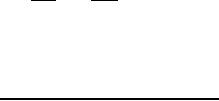 |
|||
|
Page Title:
Programming procedure for circuit G. |
|
||
| ||||||||||
|
|  MIL-M-38510/203E
i. To verify programming, after tD (10 μs) delay, lower VCC to VCCH = +5.5 0.2 V, and apply a logic "0" level
to CE1 and CE2 inputs. The programmed output should remain in the "1" state. Again, lower
VCC to VCCL = +4.5 0.2 V, and verify that the programmed output remains in the "1" state.
j. If any bit does not verify as programmed it shall be considered a programming reject.
4.10 Programming procedure for circuit G. The programming characteristics on table IVD and the following
procedures shall be used for programming.
a. Connect the device in the electrical configuration of programming. The waveforms on figure 5d and the
programming characteristics of table IVD shall apply to these procedures.
b. Select the desired word by applying high or low levels to the appropriate address inputs. Disable the
device by applying a high level to one or more `active low' chip Enable inputs. NOTE: Address and Enable
inputs must be driven with TTL logic levels during programming and verification.
c. Increase VCC from nominal to VCCP (10.5 0.5 V) with a slew rate limit of IRR (1.0 to 10.0 V/μs). Since VCC is
the source of the current required to program the fuse as well as the ICC for the device at the programming
voltage, it must be capable of supplying 750 mA at 11.0 volts.
d. Select the output where a logical high is desired by raising that output voltage to VOP (10.5 0.5 V). Limit
the slew rate to IRR (1.0 to 10.0 V/μs). This voltage change may occur simultaneously with the VCC
increase to VCCP, but must not precede it. It is critical that only one output at a time be programmed since
the internal circuits can only supply programming current to one bit at a time. Outputs not being
programmed must be left open or connected to a high impedance source of 20 kΩ minimum (remember
that the outputs of the device are disabled at this time).
e. Enable the device by taking the chip enable(s) to a low level. This is done with a pulse PWE for 10 μs.
The 10 μs duration refers to 5.0 V (0.25). The time that the circuit (device) is enabled, normal input levels
are used and rise and fall times are not critical.
f. Verify that the bit has been programmed by first removing the programming voltage from the output and
then reducing VCC to 5.0 V (0.25 V). The device must be Enabled to sense the state of the outputs.
During verification, the loading of the output must be within specified IOL and IOH limits.
g. If the device is not to be tested for VOH over the entire operating range subsequent to programming, the
verification of step 4.10f is to be performed at a VCC level of 4.0 volt (0.2 V). VOH, during the 4 V
verification, must be at least 2.0 V. The 4.0 V VCC verification assures minimum VOH levels over the entire
operating range.
h. Repeat steps 4.10b through 4.10f for each bit to be programmed to a high level. If the procedure is
performed on an automatic programmer, the duty cycle of VCC at the programming voltage must be limited
to a maximum of 25%. This is necessary to minimize device junction temperatures. After all selected bits
are programmed; the entire contents of the memory should be verified.
i. If any bit does not verify as programmed it shall be considered a programming reject.
26
|
|
Privacy Statement - Press Release - Copyright Information. - Contact Us |